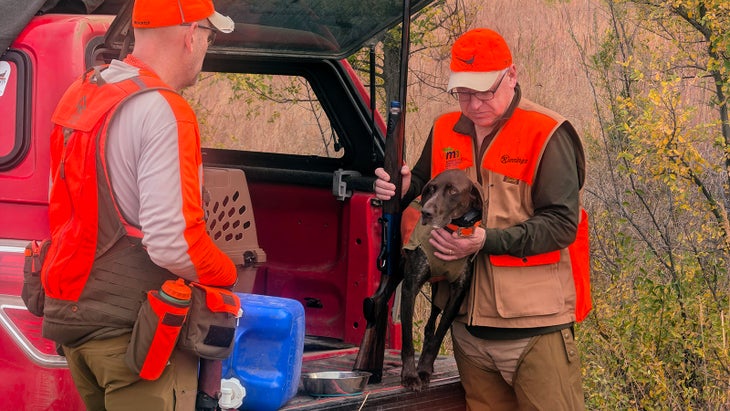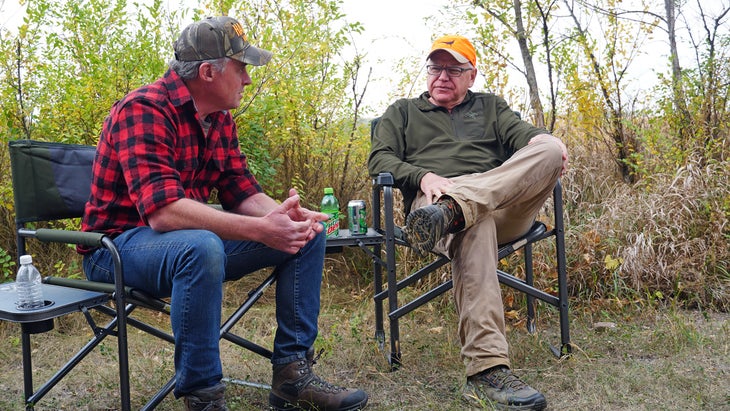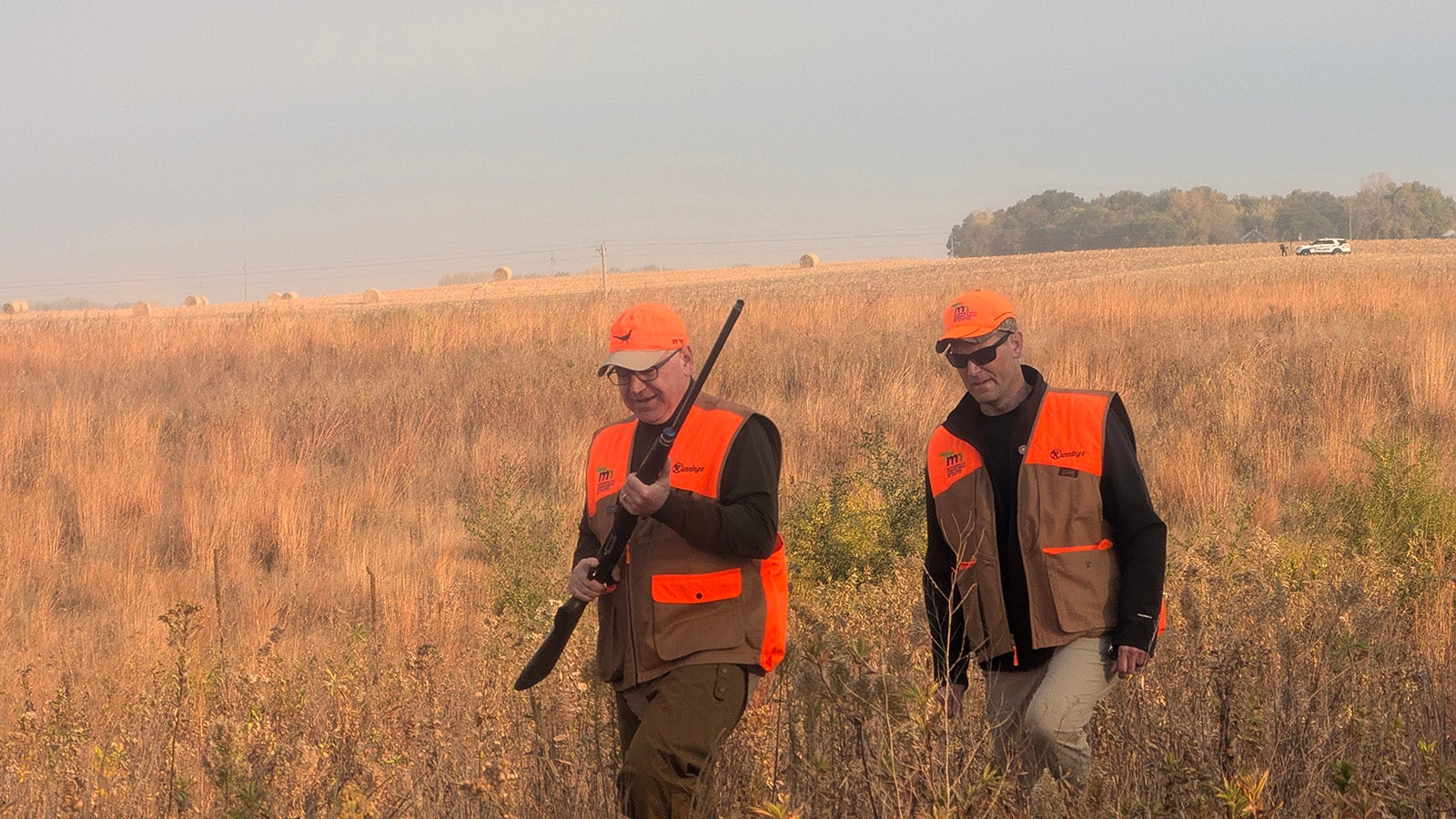Last Friday I hiked back into a camp just south of the Bob Marshall Wilderness in Montana after a long morning chasing elk around the mountains. I fired up my Starlink satellite internet system, sat down, and texted my wife to let her know I was safe. That’s when my phone rang. On the other end was one of Tim Walz’s press people, who invited me to join the Minnesota Governor and vice-presidential candidate for the annual pheasant season opener in his home state. I’d planned to interview President Joe Biden before he dropped out of the 2024 race, have previously published articles on Pete Buttigieg and John Kerry, and Walz’s press team knew I was a hunter, too.
I had just enough time to make it if I jumped in my truck and drove over 1,000 miles to southeastern Minnesota right away.��I’ve heard worse ideas, so I pulled on a pair of jeans, threw on a flannel shirt, and hit the road.
Eighteen hours later, I was standing in a field outside a town called Sleepy Eye, Minnesota, drinking a bad cup of gas station coffee, and getting frisked by the Secret Service when a convoy of armored Chevy Suburbans pulled up. Walz hopped out, pulled on a bird vest and a pair of brush chaps. A member of his personal protection detail handed him a shotgun. That’s when a trio of very excited labs jumped on the governor.
The dogs belonged to a Minnesota Department of Natural Resources official who’d showed up that morning to serve as his boss’s dog handler. Also present was the owner of the farm where everyone was parking, a dozen or so campaign staffers, at least 20 Secret Service agents supported by even more state police officers, and a gaggle of local and national news cameramen.
When the campaign representative called me at camp, I’d offered to swing by my home in Bozeman, Montana, to grab my shotgun. While the Secret Service didn’t mind people joining Walz in the field with their own bird guns, the campaign staffers didn’t want to risk a gaffe (or worse). So I just threw on my orange vest, and tagged along while Walz and the DNR official hunted.
An Unusual Hunt
Walking off the farm onto a public Wildlife Management Area, the hunt began in earnest. We’d heard some roosters calling from a��thicket of willows, so Walz, the DNR official, and his dogs waded right into them.
The field was covered in a patchwork of tall grasses, dense willows, and milo (a corn-like stalky plant that produces bird seed). There were ample signs that whitetail, birds of prey, and other wildlife had been present in the area. But this morning, we saw no trace of fauna. The Secret Service had begun showing up days earlier, patrolling the area on ATVs, setting up sniper overwatch locations, and flying surveillance drones. All these preparations seem to have scared off any deer, hawks, or other animals that usually call the area home.
Stomping along right behind Walz, straight into the willows, was an army of news media personnel, each of them competing for the perfect photo. None of the press I chatted with had ever been on any sort of hunt before.
Everyone followed along at an arm’s length, occasionally rushing ahead to capture a portrait when the sun was just right, or shouting a request to look in the camera’s direction. Frustrated members of the protective detail—some of whom were seasoned hunters—tried to hold everyone in an even line with their protectee, giving him some clear shooting angles in case a bird might fly up.
Ten minutes in, I started to wonder where the birds had been placed. Every other pheasant hunt photo-op I’ve seen a politician host was done with pen-raised birds released just moments before the politician shouldered their gun and shot them. My first assumption on the hunt with Walz was that somebody had screwed up, failing to place the birds in the pre-planned locations. But as the morning went on I realized something else was going on: Walz was really hunting wild birds.
Safety First
As we walked across the field, a rooster lifted off a few feet in front of me, on a trajectory to fly right over my head. I dove into a ditch, a reflex precaution I’ve developed for safety over years of hunting—bird hunters have reputation of playing fast and loose with gun safety. It would have been a home run shot for Walz, who was standing just ten yards away at the time, but he didn’t even shoulder his Beretta. If we’d switched places, I’d have taken that shot.
The rest of the morning, I never once saw the Governor point his gun in anything but a safe direction, even as all of those members of the press ran around him. Walz treated the entire direction of the staging area—the crowd of staffers and parked cars—as off-limits throughout the whole hunt. He unloaded his gun when we got within a quarter-mile of the pen.

A Little R&R
A couple hours later, after walking��two subsequent teams of dogs to exhaustion, Walz cracked a Mountain Dew and chomped into a venison stick made by one of his friends.
“Wasn’t that great?!” The governor remarked with enthusiasm. Most other hunters I know would have spent the time talking about the heat or lack of wind, or wondering where all the birds were hiding. But Walz didn’t seem at all frustrated by the circus that had limited his opportunities to shoot birds.
“I’m here for the camaraderie and I’m here for the dogs,” Walz told me during a sit-down interview a few minutes later. “The shooting is tertiary at best. Even watching them flush when you don’t get a shot because you’re too far away or whatever? That’s great.”
Walz gestured at the field we’d just spent a couple of hours walking. “This,” he said, “is why I come.”

A Gun Enthusiast on Gun Reform
Walz, a��former command sergeant major in the Army National Guard,��brought his along on the hunt. The $2,159 semi-automatic shotgun is an interesting choice for bird hunting.��It’s designed for shooting sporting clays, and is about 30 percent heavier than a pure hunting gun as a result.
“As I’m getting older, I appreciate the lower recoil,” Walz said. Not only does the weight reduce the Xcel’s kick, but the gun also employs a hydraulic damper in the stock to minimize the force that reaches the shooter’s shoulder.
Walz is running three-inch shells through the 12 gauge, filled with��number five bird shot. That’s about as powerful of��a load as you’d want to shoot at a pheasant, so it’s understandable why he’s gone through the effort to minimize recoil. He also employs non-toxic bismuth loads, which don’t cause lead poisoning in the birds of prey that occasionally scavenge the carcasses of hunted pheasant.
The loads retail for about three times the price of the cheaper, but less hard-hitting steel alternative. I asked the Governor how he justifies the cost. “Well I only need two rounds a day,” he responded. “In the context of the dogs and the time, that’s really not bad.”
For those not super familiar with bird hunting, Walz was bragging. The daily bag limit for wild pheasant in Minnesota is two birds.
I also asked Walz how he navigates his enthusiasm for guns and hunting while reckoning with the mass shootings that regularly shake the nation. On the campaign trail, Walz has spoken at length about how the 2012 Sandy Hook massacre reshaped his thinking on gun violence and gun control. Walz went from boasting about an “A” rating from the NRA before that mass shooting to holding an “F” rating.
“The solution is in the middle,” he told me. “Firearms are a right. So long as you can use them safely as you see here you can use them as you see fit. But here in Minnesota we’ve done things like more expanded background checks and domestic violence protection orders.” None of those things have impacted Americans’ Second Amendment rights or the guns they hunt with and own, he said.
“What it does is keep more people safe. And I think there’s a responsibility for gun owners to speak up on this, and set a good example,” said Walz.
Unexpected Access
Early in the hunt, a rooster took wing right in front of Walz. The DNR official beat his boss to the shot and brought the bird down. That was a faux pas—it should have been Walz’s shot based on proximity to the bird. But Walz immediately shouted, “Good shot!” Then he��went about helping to find the bird in the dense brush.
The striking thing about the hunt wasn’t that it actually involved fair chase and wild birds, or that Walz had a good time pursuing a hobby he’s enjoyed since childhood; it was the attitude of everyone around him.
With high-profile politicians, standard procedure for journalists is to get campaign approval for the questions you plan to ask during an interview. Hanging out after hunting wrapped up, I was chatting with the candidate’s traveling press secretary, and I asked her if there were any topics she preferred that I avoid. She just shrugged and told me to ask whatever I wanted.
The campaign is running a last-minute, incredibly close race. But everyone around Walz was relaxed and seemed to be having a good time.
The only time I saw Walz remotely bummed out was when he learned that I’m also an enthusiastic bird hunter, but didn’t get an opportunity to do any shooting. “We’ll have you back out after the election,” he said. “Then we should be able to do this without all the cameras.”
Want more stories from Wes Siler? Sign up for the .


